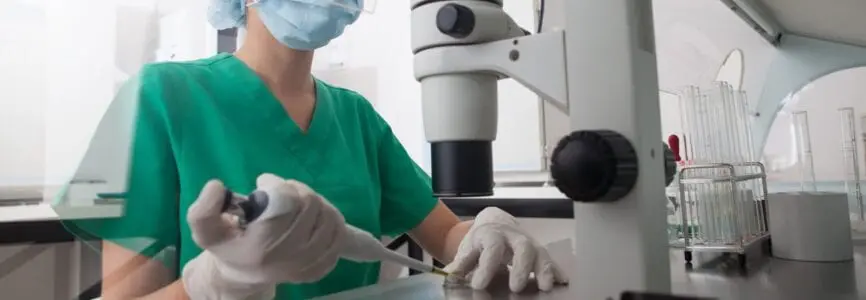Bioethics Forum Essay
FDA Proposal for Regulating Laboratory Diagnostics Could Improve Patient Care
Wendy Chung’s commentary last month about the FDA’s proposed draft guidance for the regulation of laboratory-developed tests (LDTs) is heavily critical of the agency’s plans. Professor Chung argues that the FDA’s involvement in this space will have two primary negative consequences: it will stifle innovation and it will harm patient care.
But the FDA’s proposal seems designed to address precisely these two consequences. The proposal could improve patient care by collecting, for the first time, clinical validity data on tens of thousands of LDTs in current use. And by using an extensive system of carve-outs, the FDA is seeking to minimize potential harms for diagnostic innovation. Understanding these key portions of the FDA’s disclosure to Congress is critical to a full policy discussion of the situation.
The Importance of Clinical Validity Data for Patient Care
Imagine that you are a woman with an extensive familial history of breast cancer. You worry that you may have inherited a genetic mutation in one of your BRCA genes, and you would like to obtain a genetic test to determine that fact. The only commercial provider of such tests advertises a test for 10 possible mutations in those genes. You can be sure that the test accurately detects the presence or absence of those 10 mutations. This is because (as Professor Chung notes) all laboratory testing in the United States is currently regulated by the Clinical Laboratory Improvement Amendments (CLIA), under the auspices of the Center for Medicare and Medicaid Services (CMS).
But here’s the problem: because CLIA only tests for analytical validity, you can’t be sure that the test has any clinical validity at all. That is, whether you test positive or negative, you can’t know how likely it is that you’ll develop breast cancer. It might be that the 10 mutations tested for only increase your chance of developing breast cancer by 5 percent. And it might be that there are 100 other mutations not tested for which could dramatically increase your risk. The FDA is proposing, for the first time, to determine how well such a test can predict a woman’s risk for breast cancer.
Many LDTs are serious tests, with serious implications. A doctor may recommend (and a woman may decide to have) a prophylactic mastectomy or not on the basis of such a test. Patients deserve relevant information about the risks and benefits of making such choices. Under current regulations, CLIA doesn’t give them that information.
Professor Chung argues that right now labs frequently incorporate new discoveries into their existing LDTs. Perhaps this is akin to the BRCA test provider in my example finding out about the additional 100 mutations and including those in the test. Unfortunately, this may not happen for a variety of reasons. One potential factor is the availability of patents. If a company has patented an LDT, it has no competitive incentive to improve its test rapidly on the basis of externally discovered information (an issue I’ve written about in a Note in the Harvard Law Review). Indeed, it might even deploy its patent to prevent others from accumulating such information. The FDA’s proposal, if thoughtfully implemented, might require such improvements
FDA’s Efforts to Decrease the Regulatory Burden on Innovators
The FDA has also recognized the potential negative effects that a broad-based scheme of LDT regulation could have on diagnostic innovation. To that end, the FDA’s draft guidance document proposes a series of carve-outs and procedural accommodations to minimize any additional regulatory costs on many LDT providers.
Many of these carve-outs map precisely onto the concerns that Professor Chung mentions. For instance, she notes that LDTs are “commonly used when there is no FDA-approved test.” The FDA agrees that this is an important category of tests, and has proposed to require such “LDTs for unmet needs,” as they have called them, only to register with the FDA and report adverse events. Unlike many other LDTs, these will not be subject to premarket review requirements or additional quality regulation. LDTs for rare diseases and LDTs that would’ve been available in the 1970s (“traditional LDTs”) are similarly granted this carve-out.
Another key procedural accommodation is that the FDA plans to accept information from the literature to establish clinical validity where such information exists. That is, in many cases (such as the breast cancer hypothetical scenario above) laboratory manufacturers will not need to conduct clinical trials or extensive monitoring studies to demonstrate clinical validity. They will be permitted to rely on the research that they and the scientific community have already done. This is a significant concession that could dramatically decrease the regulatory burdens involved.
There are certainly lessons for the FDA to keep in mind going forward, several of which are discussed in Professor Chung’s commentary. For instance, it would surely be a good idea for the FDA to coordinate as much as possible with CMS to minimize any duplication in regulation and the attendant costs it would impose. But it is important both to recognize the advances in patient care that are likely to come from the FDA’s proposed regulation and to view the series of exceptions in the draft guidance as an indication that the FDA cares about innovation. With the inevitable challenges to this guidance, both statutory and constitutional, it is by no means assured that the FDA will achieve its goal. But a fully realized policy debate about the FDA’s proposal requires thorough consideration of the complexities around both innovation and patient care.
Rachel Sachs, JD, MPH, is an Academic Fellow at the Petrie-Flom Center for Health Law Policy, Biotechnology, and Bioethics at Harvard Law School.
Posted by Susan Gilbert at 09/04/2014 03:50:40 PM |













